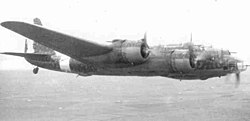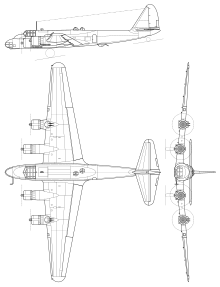Piaggio P. 108
| Piaggio P. 108 | |
|---|---|

|
|
| Type: | bomber |
| Design country: | |
| Manufacturer: | |
| First flight: |
November 24, 1939 |
| Number of pieces: |
30–35 (including 24 bombers) |
The Piaggio P.108 was a heavy four-engine bomber made by the Italian manufacturer Piaggio , which was used by the Regia Aeronautica and the German Air Force during the Second World War .
The P.108 was a further development of the P.50-II . After the first flight in 1939, the first missions took place in 1942. Four versions were produced in small numbers.
P.108 bomber version
The P.108 has been developed by Piaggio since 1937. The first flight of the prototype MM22001 took place on November 24, 1939. By August 1943, a total of 24 bombers including the prototype had been delivered: MM22001–22008, 22601–22604 and 24315–24326. The delivery of the first eight aircraft ordered was very slow. In May 1941, the Regia Aeronautica set up the 274a Squadriglia, which should be equipped with this pattern. It received the MM22003 as the first aircraft. On August 7, 1941, Bruno Mussolini, one of Benito Mussolini's sons , had a fatal crash landing in this plane. Some planes could be armed with a torpedo each.
The first combat mission was flown with two aircraft on June 9, 1942. Several attacks were carried out on Gibraltar during the year . The squadron was increasingly used from November 1942 to repel the Allied landings in North Africa . The majority of the aircraft were lost in these combat missions. On August 9, 1943, the 274a Squadriglia still had five aircraft in stock, two more were at Piaggio for repair. The German Air Force took over the still existing aircraft after September 1943, but only used them to obtain spare parts for the transport version P-108 T. The P.108 A suffered the same fate.
The MM24318 was converted to the P.108 A from December 1942. Instead of the glass bow, it was given a fixed bow cladding, into which a 102 mm cannon was installed for fighting ships. The first flight in this constellation took place on March 3, 1943. There was no combat mission, even if it was planned to equip other aircraft from the T-series with this weapon.
P.108 C and T
At the beginning of 1940, the airline LATI showed interest in the Boeing 307 , which, due to its range and payload, seemed well suited for South American traffic. LATI suggested acquiring the license and having the aircraft built in Italy. As an alternative, the Italian Ministry of Aviation decided to develop a civil aircraft based on the P.108 bomber. For this, the wings, the tail unit, the engine nacelles and the landing gear of the bomber were taken over, while the fuselage was redesigned with a diameter of 3.25 m. The installation of a pressure ventilation was planned. The 32 passenger seats were accommodated in four compartments. Pratt & Whitney engines or the Piaggio P.XII could be used as drive.
From March 1942 the military transport version P.108 T was developed from the P.108 C, which was to have a rotating tower on the back of the fuselage. The P.108 C (MM496) first flew on July 16, 1942, the first flight of the T-series took place on September 7, 1942 (MM24673). The second aircraft (MM24668) was handed over to the SAS 248a Squadriglia in April 1943. Up to August 1, 1943, only two more aircraft could be delivered. The German Air Force decided to continue building the model after the armistice . Seven more aircraft had been delivered by August 1944. The aircraft were assigned to the IV. Group of Transport Wing 4 (a total of twelve T and C aircraft), which also flew the Junkers Ju 90 and later other large multi-engine aircraft of German and Italian origin. The squadron was used on the Eastern Front and in the Balkans until the aircraft were decommissioned in August 1944 due to lack of fuel. Eleven or twelve aircraft were built of version T (MM24667–24678 were ordered).
P.133
A further development of the P.108 was the P.133, the prototype of which was well advanced at the time of the armistice (September 3, 1943). However, the program ended shortly thereafter without the prototype being completed. The aircraft received a lighter structure and should achieve improved performance after the results of the investigation of a captured Consolidated B-24 Liberator were incorporated into the development. The P.133 should reach a calculated speed of 490 km / h and be equipped with six 20 mm and four 12.7 mm automatic cannons and be able to carry a bomb load of up to 4800 kg.
variants
- P.108 Bombardier , heavy bomber, 24 pieces
- P.108A Artigliere , for ship combat , 102 mm cannon, 1 piece (conversion MM 24318)
- P.108C Civile , passenger aircraft, 32 passengers, 1 piece (MM 496)
- P.108T transport version , 60 soldiers, 11 or 12 pieces (MM 24667–24678)
- P.112 variant with Piaggio P.XXII engines
- P.114 planned variant with floats
- P.133 further developed bomber, prototype was not completed
Military use
Technical specifications
| Parameters | Data (Piaggio P.108B) |
|---|---|
| crew | 6th |
| length | 22.20 m |
| span | 32 m |
| height | 6 m |
| Wing area | 135 m² |
| Empty mass | 17,325 kg |
| Max. Takeoff mass | 29,885 kg |
| drive | 4 × 18-cylinder double radial engine Piaggio P.XII RC.35, each 1,500 PS (1,103 kW) |
| Top speed | 430 km / h |
| Range | 3520 km |
| Service ceiling | 8500 m |
| Armament | 5 × 12.7 mm machine guns, 2 × 7.7 mm machine guns, 3500 kg bombs |
See also
literature
- David Mondey: The Hamlyn Concise Guide to Axis Aircraft of World War II. Chancellor Press, London 2002, ISBN 1-85152-966-7 .
Web links
Individual evidence
- ^ Federal Archives / Military Archives Freiburg, holdings RL 3, production programs
- ↑ Brotzu, Caso, Cosolo: Dimensione Cielo No. 6: Bombardieri. Rome 1973.
- ↑ Storia Militare, No. 79 April 2000 ( Memento of August 8, 2014 in the Internet Archive )
- ^ Piaggio P.108 ( Memento of August 17, 2011 in the Internet Archive )

